How Much Do Solar Panels Cost?
Last Updated: 6th Jul 2025 By Finn Peacock, Chartered Electrical Engineer, Fact Checked By Ronald Brakels
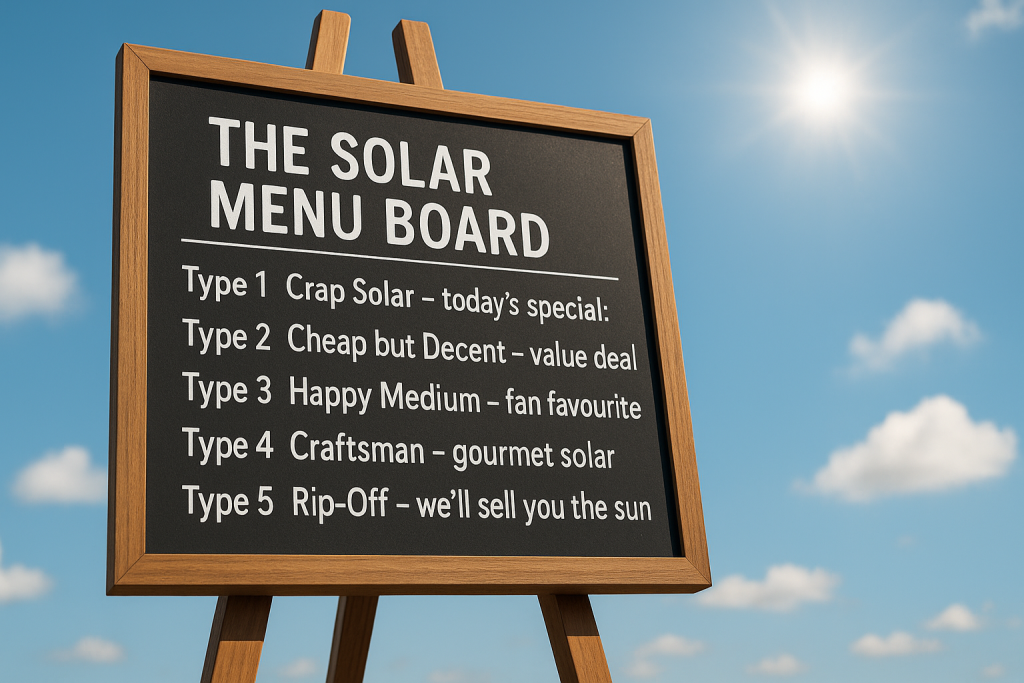
When people ask me,
“Finn, what do solar panels cost these days?”
…they’re usually not asking how much an individual panel costs – knowing the price of a single panel isn’t very useful.
What they usually want to know is,
“What will it cost me to put a decent-sized solar power system on my roof?”
This page will answer that question first, and then get into individual panel prices later.
I’ll also explain how much of your solar system’s cost goes to the panels themselves, and the effect of the solar panel rebate.
- How Much Does a Fully Installed Solar System Cost?
- The 5 Types of Solar Installers (Only 3 Are Worth Your Time)
- What Affects the Cost of a Solar System?
- The Solar Rebate: How STCs Work
- How Much Do Panels Actually Cost?
- How Much of the Panel Cost is Covered by the Rebate?
- So What’s the Difference Between Cheap and Expensive Panels?
- Breaking Down a 10 kW System Cost (budget vs. premium)
How Much Does a Fully Installed Solar System Cost?
Since May 2023, 1811 Aussies have told us what they paid for a 10 kW solar system. As of March 2025, its ~ $10,000 fully installed, down from ~$11,000 in early 2023. This is despite the solar rebate reducing twice, in Jan ’24 and Jan ’25.
Pro-tip: In our Price Explorer tool, you can change the system sizes, check pricing on a state-level, and apply filters like specific panel & inverter brands to this graph
But $10,000 is the average. People paid from $7,000 to $20,000 for their 10 kW systems. So what causes the price differential?
The #1 factor is what kind of solar panel installer you choose to go with – from crazy cheap to wildly expensive.
Let me explain…
The 5 Types of Solar Installers (Only 3 Are Worth Your Time)
I’ve learned you can generally put solar installers in 5 categories:
| Type | Installer Category | Description | Recommended by SolarQuotes? |
|---|---|---|---|
| Type 1 | Crap Solar | Cheapest price = worst quality. Dodgy gear, dodgy installs, dodgy warranties. |
❌ |
| Type 2 | Cheap but Decent | No-frills, efficient operators. Good value if your install is simple and you’re in a metro area. Limited options, mostly remote quotes, minimal handholding. |
✅ |
| Type 3 | Happy Medium | Balance of price, quality, and service. Includes site visits, shade analysis, hardware choices. Great for slightly tricky installs or folks who want options and advice. |
✅ |
| Type 4 | Expensive (Craftsmen) | Top-tier installers with obsessively tidy work. Best brands, deep knowledge of batteries/monitoring/custom setups. Ideal for complex homes, premium systems, or when you want it perfect. |
✅ |
| Type 5 | Expensive (Rip-Off) | Hard sell tactics, inflated prices, average or poor hardware. Rely on getting you to sign before you compare quotes. Avoid like the plague! |
❌ |
Do you want your installer to be:
- Simple & cheap? Pick Type 2.
- Well-balanced? Pick Type 3.
- Premium & perfectionist? Pick Type 4.
SolarQuotes only ever deals with installers of type 2, 3 and 4. If we ever give you quotes from a type 1 or a type 5 installer, reach out to us — something went wrong!
What Affects the Cost of a Solar System?
But it’s not just the installer you choose. Other factors will determine the cost of your solar system, too:
1) System size
The price of your new solar system will, of course, depend on how big the installation is. That is how many kilowatts (kW) of solar panels you install.
Here’s the typical range people paid for different-sized solar systems – but as a simple rule of thumb, budget ~$1,000 per kW installed for a decent quality system – dully installed on your home.
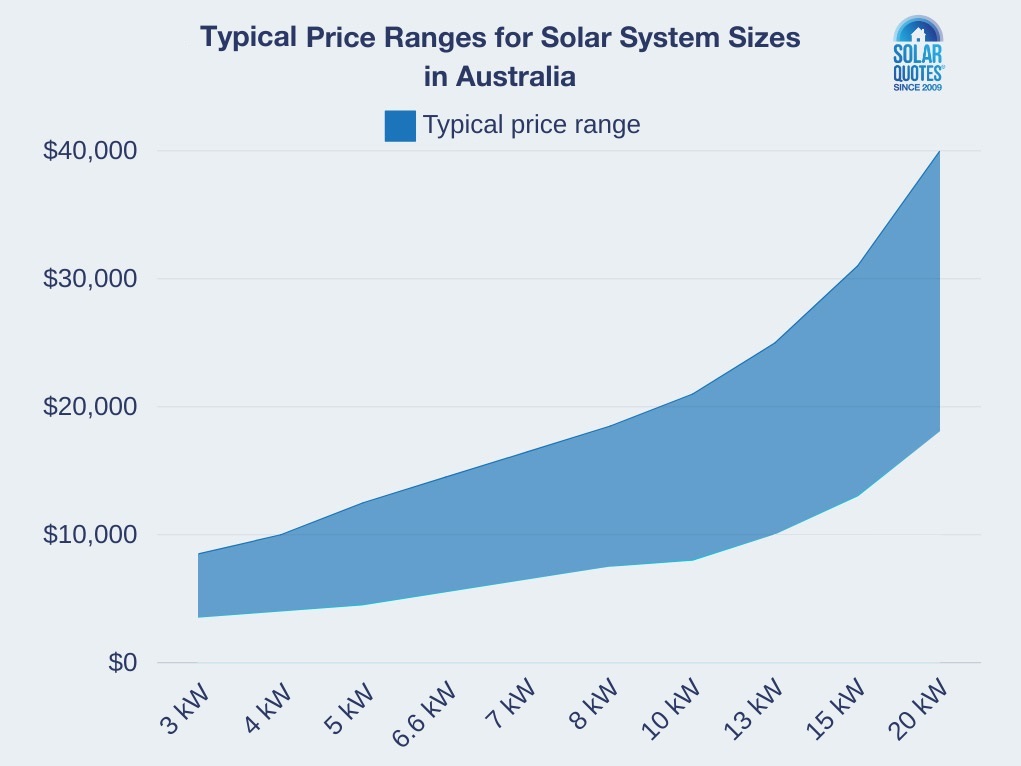
2) Panel brand (budget vs. premium)
The brand of panels you choose influences your system cost.
10 kW of ‘Rolls-Royce’ panels such as REC can easily be double the cost of good budget panels like Jinko. I’ll go into premium vs. budget panel costs and whether to pay the extra in great detail later….
3) Inverter brand
Another element that contributes to the overall cost of your system is the inverter brand. Choosing a premium 10 kW inverter brand, like Fronius can easily add $1,500 to the system cost over a good budget unit such as Goodwe. You can find a cost overview of solar inverters sold in Australia here.
4) Installation difficulty
Installers charge extra for:
- double-storey
- tiled roof
- steep roofs (more than 25°)
- inverter installation a long way from your switchboard
- switchboard upgrades where required by local regulations
- mains-supply upgrades to fix voltage-rise issues on skinny grid connections
5) Location (regional vs. metro)
The further you live from your nearest installer, the more expensive it can get. Some installers charge an extra travel fee for anything further than 80 km.
If your installer needs to travel so far they require accommodation for an overnight stay, that can raise the cost significantly.
6) Overheads (GST, sales, margin etc.)
Like any business, solar installers will also mark up their prices to cover their overheads. And they have to charge GST on the cost before rebates (so don’t freak out when the GST is more than 10% of the price paid!).
Which brings us nicely to:
The Solar Rebate: How STCs Work
When you buy solar in Australia, the government gives you an upfront discount at the point of sale—no paperwork, no waiting. This rebate is actually based on something called Small-scale Technology Certificates (STCs).
Here’s how STCs work: your solar system generates clean energy, and the government rewards you for this by issuing STCs proportional to the system’s size (panel capacity in kW). Installers typically handle these certificates for you, immediately applying their value as a discount off your installation price.
Importantly, the rebate doesn’t depend on panel quality or brand, just on how much solar capacity you install. Simply put: the bigger your solar system, the more STCs you get, the bigger your rebate.
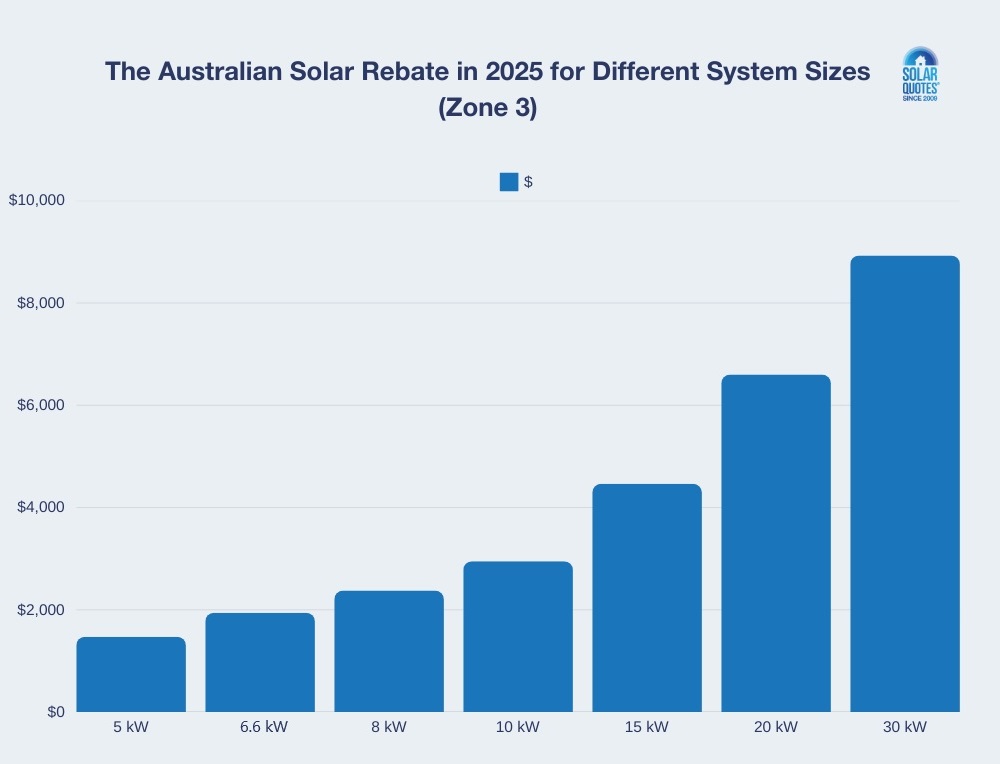
One thing to remember: the value of this rebate decreases slightly every January, as the government slowly winds the scheme down. Fortunately, solar panel prices have also been steadily falling, which helps offset that drop.
How Much Do Panels Actually Cost?
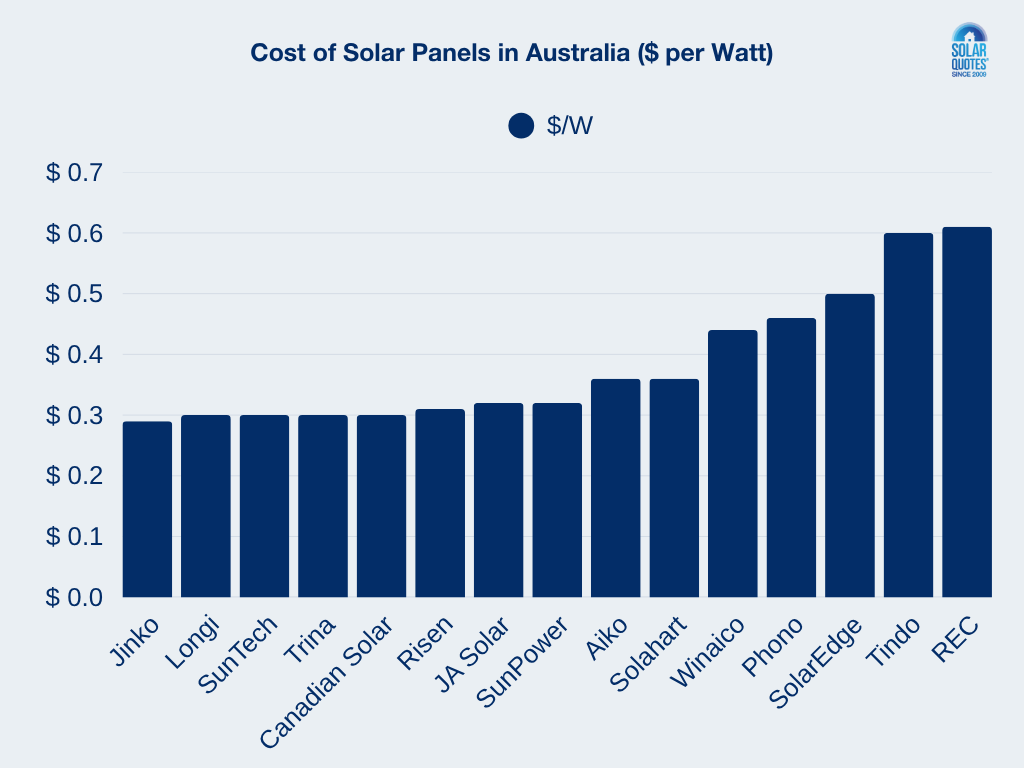 The solar panel brand you choose still affects the final system cost, but panel pricing has become so competitive that the difference between budget and premium panels is now much smaller than it used to be.
The solar panel brand you choose still affects the final system cost, but panel pricing has become so competitive that the difference between budget and premium panels is now much smaller than it used to be.
Let’s look at an example. A budget-friendly panel, like Jinko, might set you back around $130 per panel, whereas a premium panel like SunPower could easily cost over $290 each. That means your panel choice alone can create an extra cost difference of about $3,600 for a full 10 kW setup. And remember, that’s just panels—not counting inverters, installation, or anything else!
How Much of the Panel Cost is Covered by the Rebate?
In 2025, a typical 10 kW solar system will earn you around $3,000 off the price at the point of sale. If you chose budget panels, the rebate covers almost the entire cost of the panels:
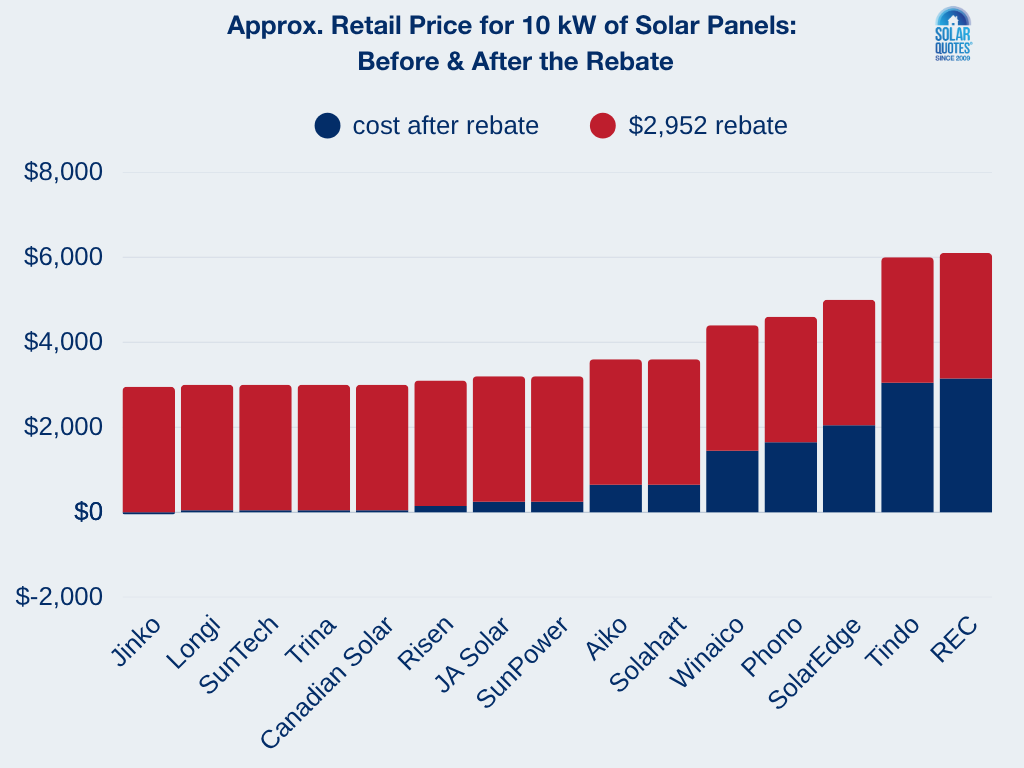
The solar rebate can cover the cost of the solar panels if you pick a budget brand. However, that does not mean you get a free system!
However, when you choose premium panels, you are still paying for about half of the panel cost.
So What’s the Difference Between Cheap and Expensive Panels?
Why would anyone pay extra for premium panels? Well, you do get a few key benefits:
- Higher efficiency – Premium panels squeeze a bit more electricity out of every square metre. Great if your roof is small or partially shaded. However, budget panels nowadays get pretty close so the improvement is marginal.
- Lower degradation – Cheaper panels might lose around 10% efficiency over 25 years, whereas top-tier panels usually only lose about 5%.
- Better heat tolerance – Premium panels have a lower temperature coefficient (PMax), meaning they produce more energy during scorching Aussie summers.
- Superior warranties – Most premium panels come with solid 25–30 year warranties, and some even cover labour.
- Trusted reputation – With premium brands, you’re paying for proven reliability and strong support if you ever have warranty issues.
But look, most people don’t necessarily need the Rolls Royce of panels. If you’re budget-conscious, there are plenty of solid, value-for-money options out there. Brands like Jinko, Trina, and LONGi all deliver quality, reliability, and good performance—and are regularly installed by reputable installers across Australia.
Bottom line: Your panel brand choice can swing the total cost of your solar quote by a few thousand. Premium brands could be worth the extra spend (if you’re a solar snob like me)—but only if efficiency, longevity, and peace of mind matter a lot to you.
Breaking Down a 10 kW System Cost (budget vs. premium)
If you request a quote for a 10 kW system consisting of budget panels like Risen, the cost of that system can be broken down to something like this:
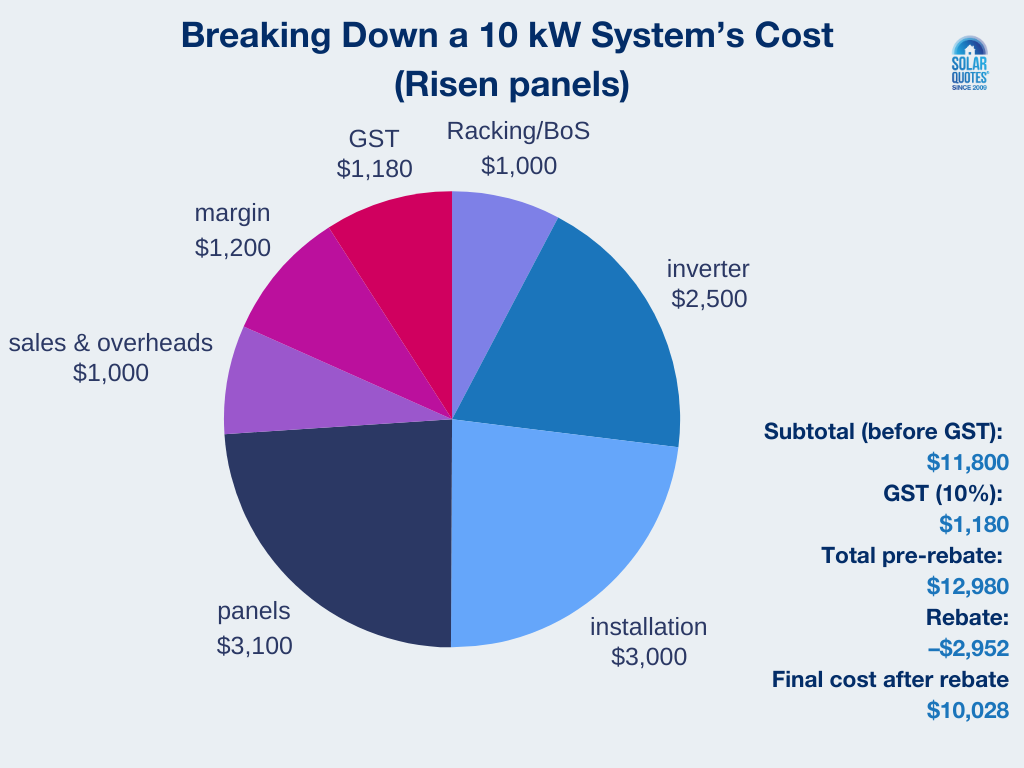
In the case of a budget brand system, the panels will only make up about 25% of the system cost. However, when we look at a 10 kW system consisting of the top-of-the-line REC Pure Alpha-RX, the panels take up almost 37% of the entire system cost.
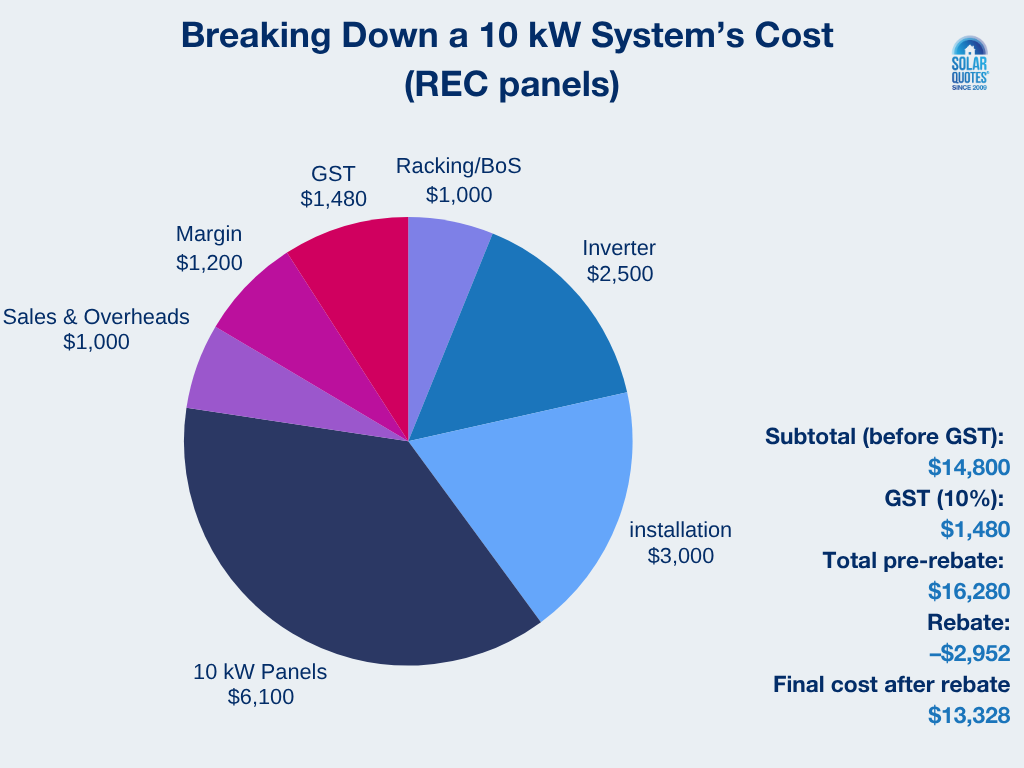
With a premium brand like REC, the solar panel brand makes up 37% of the entire system’s cost.
Remember: the rebate is not affected by your brand choice, but by your system size. This means that the Risen system gets the same point-of-sale discount as the REC system (about $3,000 for 10 kW).
This $3,000 discount translates to a 23% discount for the Risen system but only an 18% discount for the REC system.
Wrap-Up: What You Can Expect to Pay
To sum things up:
- With the STC rebate factored in, the actual cost you’ll pay drops to about $10,000 for a 10 kW system.
- With the performance of budget panels nowadays and the narrowing price difference, it’s becoming increasingly hard to justify the extra cost of premium panels—unless you’re a solar snob like me (REC on the roof, Ferrari in the driveway—OK fine, it’s actually a Model S from back before Elon went bonkers). The trend I am seeing is that premium solar panel brands are dying.
Still curious about your specific costs?
- Use our Price Explorer tool to see up-to-date pricing data from thousands of recent Aussie solar installations.
- If this all still seems expensive to you, you can read about how good of a financial investment solar can be. You can even calculate the payback for solar in your specific situation with our solar calculator.
- Compare detailed specs and prices for individual panel brands with our Solar Panel Comparison Table.
And if you’re ready to take the plunge: